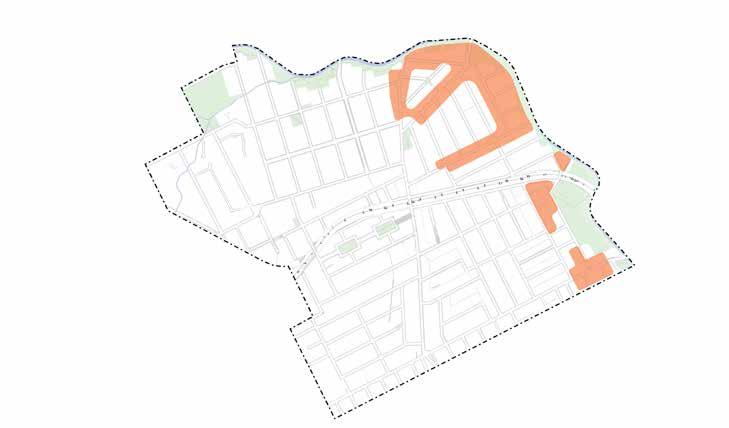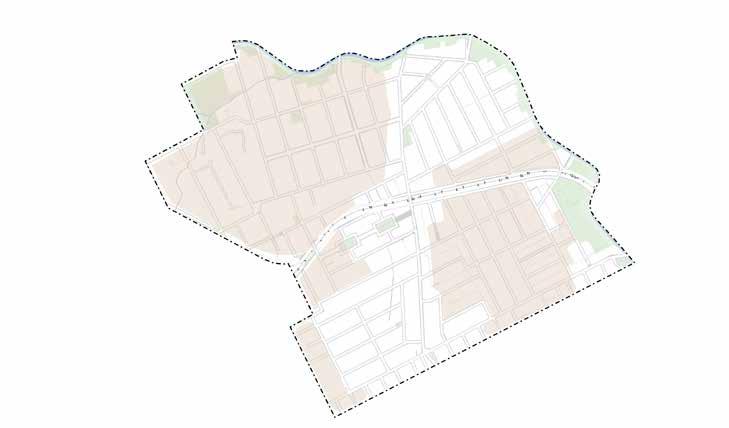
5 minute read
Intensification Strategy
from Draft Campsie Master Plan
by cbcity
2.3 Intensification Strategy
What is an Intensification Strategy?
The Intensification Strategy identifies the areas of Campsie that are seen to have the potential to respond to the increased demand for dwellings and employment. The areas identified will require updated planning controls and will help establish Campsie as a Strategic Centre. The Intensification Strategy is based on the analysis of opportunities and constraints included in the earlier phases of this Master Plan, the analysis performed as part of the Tall Buildings Study, and finally the Spatial Actions, identified in the previous section of this report.
Why has it been prepared?
The Intensification Strategy guides the planning and urban design decisions that informed the Urban Design Framework Plan, the and support Directions explored in subsequent pages of this report.
How is it structured?
The Intensification Strategy sets out five specific principles for urban renewal in Campsie:
· Intensification within walking distance of the Metro Station (400m) · Intensification within walking distance of key open spaces and improved connections to open spaces · Intensification within key node of
Canterbury Road and Beamish Street · Low intensification of areas between the key nodes (town centre, river, Canterbury
Hospital) · No intensification - Maintain existing built form controls in special character and low density areas What are the key outcomes of this Strategy?
The key aim of this strategy is to distribute development intensification across a wide area of Campsie, so as to accommodate the employment and housing growth envisaged for Campsie in Connective City 2036 and Council’s Housing Strategy and Employment Lands Strategy.
01
· Leverage from proximity to train station and position people close to public transport and support the public investment made in the upgrades to
Sydney Metro Southwest. · Leverage key sites under single ownership, as key land holders which can have a positive role in achieving the vision for
Campsie. · Retain the character of Beamish Street, by maintaining the active frontages and multiple shops along the street. Beamish
Street is rejuvenated, benefiting from the increased patronage and movement. · Retain solar access to key parks -particularly ANZAC Park, Carrington
Square and Lofts Gardens.
Suited for intensification
Intensification sensible to character and heritage along Beamish Street Retain solar access to key parks Existing Open Spaces Not to scale
02
Intensification within walking distance of key open spaces and improved streets connecting to open spaces Intensification within key node of Canterbury Road and Beamish Street
· Allow for density near the amenity –
Promote the establishment of increased density along the Cooks River leveraging proximity and access to amenity of open spaces, promoting health and well-being. · By positioning taller buildings adjacent to large areas of open space the sense of bulk and scale established by the new buildings is reduced, as the built form is viewed and perceived within its wider context. · Align areas for intensification with public benefit - leverage from the establishment of the Cooks River Trail, and connections to Canterbury Racecourse and Tasker Park. · Celebrate the intersection of Beamish
Street and Canterbury Road- place a taller building at the node, establishing a landmark at this key intersection and defining the entrance to Campsie Town
Centre from the south. · Incentives for establishment of employment-generating land uses – leverage from the location of Canterbury
Hospital to attract and promote the location of health and lifestyle uses in areas of Canterbury Road between the
Hospital and the Beamish Street node.
03

Suited for intensification (within 200m) Existing Open Spaces Suited for intensification (within key public transport corridor) Suited for intensification (incentivising Commercial uses) Existing Open Spaces Not to scale

2.3 Intensification Strategy
Low intensification of areas between the key nodes (town centre, river, Canterbury Hospital) No intensification - Maintain existing built form controls in special character and low density areas
· New dwellings away from centre at human scale and no higher than the tallest trees –
Promote a scale of buildings which are of a human scale and nature. · Human scale street wall height and diversity of building typology – For taller developments promote the establishment of a street wall height which is in context with the surrounding buildings which will be retained or not developed. · Some areas will grow with a lower intensity of redevelopment in order to maintain and enhance the existing and diverse local scale urban fabric that surrounds the
Campsie Town Centre core. This will allow for density that is keeping with the existing character and urban context.
05
· In areas outside the ones previously mentioned, urban renewal is anticipated to occur within the current planning regulations.

Suited for low intensification with small adjustment to planning controls Existing Open Spaces Low intensification limited to existing built form controls

Existing Open Spaces Not to scale
Combined Principles
This diagram identifies the ideal locations for intensification and built form density by overlaying the strategy’s 5 principles.
The optimum location for increasing development intensity in Campsie is underpinned by proximity to public transport and public open space, preservation of adequate solar access to public open space, protection of important cultural destinations and heritage and suitable built form transitions to surrounding areas.
Intensification Strategy Map

Retain solar access to key parks Leverage from proximity to train station Leverage key sites under single ownership Retain character of Beamish Street Retain character if ANZAC Park and Carrington Square and historic single storey dwellings
Proximity to Cooks River - density near amenity - sense of scale ameliorated by large open space Align areas for intensification with public benefit
Celebrate intersection of Beamish St/Canterbury Road- place height at the node Incentives for establishment of health related uses
New dwellings away from centre at human scale and no higher than the tall trees Human scale street wall height and diversity of building typology Lower intensity of redevelopment to contribute to existing character
No intensification - Maintain existing built form controls in special character and low density areas
1:10,000 (A3) 0 100m 200m










